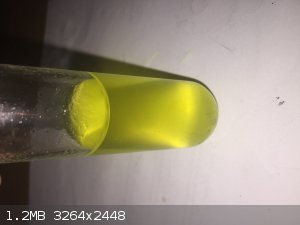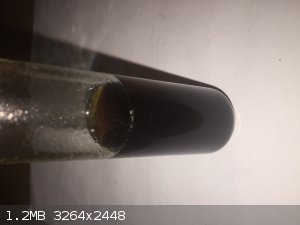LearnedAmateur
National Hazard
   
Posts: 513
Registered: 30-3-2017
Location: Somewhere in the UK
Member Is Offline
Mood: Free Radical
|
|
Chloride of manganese
Hi all, first post on the forums.
Background: I'm currently going through a period of synthesising ionic compounds for the purpose of growing crystals (they're pretty and colourful,
who doesn't love them?), including coordination complexes.
My issue is that I have attempted to synthesise some MnCl2 from the dioxide and hydrochloric acid through the reaction MnO2 + 4 HCl -> MnCl2 + Cl2
+ 2 H2O. The HCl was generated in situ by the action of concentrated sulphuric acid and sodium chloride (excess). I could detect the biting odour and
slight green colour of the chlorine gas being produced, and the signs of HCl vapour (low temperature boiling, instantaneous dissolution of evolved
bubbles, white mist at higher temperatures). To my surprise, instead of turning pink, the solution turned a very dark green colour, impenetrable to
light, then upon heating, yellow (as in the picture).
My first question is: have I synthesised manganese (IV) chloride, or sodium tetrachloromanganate? I cannot find any images for colour reference, and
my chemistry knowledge tells me that both reactions are possible;
1. MnCl2 + Cl2 -> MnCl4, where the manganese is oxidised by the chlorine.
2. [Mn(H2O)6](2+) + 4 Cl- -> [MnCl4](2-) + 6 H2O, where the chloride undergoes ligand substitution with the water, and the sodium forms a salt with
this complex.
Secondly, can I simply reduce MnCl4 to MnCl2 with heating, generating chlorine gas? What temperature would this occur at, if possible?
Thanks for the help, and please feel free to correct any erroneous assumptions I have made, feedback is always appreciated.
Edit - upon the addition of more manganese dioxide, the solution returns to the green/orange colour and more chlorine gas is evolved (image 2).

[Edited on 30-3-2017 by LearnedAmateur]

|
|
|
Tin man
Harmless

Posts: 34
Registered: 12-9-2016
Member Is Offline
Mood: Gruntled
|
|
I doubt that manganese(IV) Chloride exists because manganese(IV) tends to spontaneously oxidize the chloride ion to chlorine gas.
|
|
|
LearnedAmateur
National Hazard
   
Posts: 513
Registered: 30-3-2017
Location: Somewhere in the UK
Member Is Offline
Mood: Free Radical
|
|
So I guess that's out of the question then, I'd just assumed that the chlorine was from the initial reaction, I guess it confused me slightly because
Cl2 +2e- -> 2Cl- is a stronger oxidising reaction (by 0.128V), so it would have a higher affinity for the electrons - I guess manganese is one of
the oddball d block elements, though. The one reference I found for Na2MnCl4 has it as red crystals, so I'll have to see if my yellow solution
crystallises as such.
[Edited on 31-3-2017 by LearnedAmateur]
|
|
|
Boffis
International Hazard
    
Posts: 1901
Registered: 1-5-2011
Member Is Offline
Mood: No Mood
|
|
@LearnedAmateur, Mn4+ oxidizes Cl- to Cl quickly so any 4 valent Mn will quickly become trivalent Mn3+ and chlorine will be evolved. MnCl3 is unstable
in water and rapidly hydrolyses precipitating brown hydrated Mn3+ oxides, however, in the presence of a sufficiently large excess of hydrochloric acid
hydrolysis is slow and, particularly on warming, it becomes Mn2+ chloride (very pale pink) and more chlorine is evolved. Mn3+ solutions are dark
brownish red usually. The yellow colour is probably manganese II ions with some residual chlorine. In the presence of sulphuric acid you will probably
end up with manganese II sulphate and chlorine being evolved. Without knowing the precise molar quantities you mixed together its hard to predict the
exact outcome.
At one time this was the industrial method of producing chlorine for bleach production:
MnO<sub>2</sub> + 2NaCl + 2H<sub>2</sub>SO<sub>4</sub> → MnSO<sub>4</sub> +
2H<sub>2</sub>O + 2Cl + Na<sub>2</sub>SO<sub>4</sub>
Also bare in mind that manganese IV oxide (so called manganese dioxide) is a very complex beast and is almost impossible to obtain pure. Manganese
dioxide is usually sold as a % purity, typically about 80-90% based on the "available oxygen" which is a hangover from the days when its main use was
the production of bleach. 100% would be pure MnO2 and 0% MnO but both natural and synthetic MnO2 can carry much combined water and other metals
particularly K and Ba.
I doubt that you can produce chloromanganate IV ions in aqueous solution but chloromanganate III and possibly II may be possible. Try adding some
caesium chloride and see if you get a crystalline precipitate. Caesium forms a mixed chlorid with Mn2+ but whether this is a chloromanganate II or
just a mixed crystal I can't say, the crystals are colourless under the microscope.
|
|
|
LearnedAmateur
National Hazard
   
Posts: 513
Registered: 30-3-2017
Location: Somewhere in the UK
Member Is Offline
Mood: Free Radical
|
|
Thanks for the explanation, the manganese dioxide I used was leftover from permanganate reduction and washed with copious amounts of water so I
couldn't imagine there would be more than trace quantities of anything else. Since it was more of a test reaction (hence the very small quantity), I
admittedly just threw reagents into the boiling tube to see what would happen so I can't tell you how much of what I used - purity is only a concern
during the crystallisation phase, for me in this case. All I can say is that there was sufficient NaCl to completely neutralise the H2SO4, with a
large amount of NaCl/Na2SO4 precipitating upon cooling.
Also, I don't have any access to caesium chloride nor the funds for such small quantities; could you recommend any other tests, preferably with
commonplace reagents, that I can perform? Bar that, I'll strongly heat the mixture and reduce volume by half to see if the yellow colour disappears,
albeit I already have put it through a rolling boil for 2-3 minutes and I couldn't detect any colour change nor chlorine odour, only that of small
quantities of HCl, if those observations are of any use.
|
|
|
AJKOER
Radically Dubious
    
Posts: 3026
Registered: 7-5-2011
Member Is Offline
Mood: No Mood
|
|
Remember: Mn is an active transition metal including undergoing so called metal auto oxidation with dissolved O2, except when it is already at its
highest oxidation state. The reaction introduces the superoxide radical which can react with H+ to form the HO2 radical (if pH < 4.8) which may
self react, for example, producing in situ H2O2 and some O2. In the presence of Mn in a lower valence state, H2O2 (EDIT: and also HOCl, from the
action of Cl2 and H2O, in place of hydrogen peroxide, forming Cl- and .OH in a related REDOX) could feed a Fenton-like REDOX which also could,
depending on pH, produce the hydroxyl radical (.OH) and OH-. Also, small amounts of other transition metals, possibly present as impurities like Fe,
along with strong light exposure, may accelerate the Fenton/Photo-Fenton and associated Fenton-like reactions as well.
In other words, for example, when boiling in the presence of air/O2, the chemistry gets more complex as you just added a new reagent to the mix, and
reaction products could be altered.
[Edited on 31-3-2017 by AJKOER]
|
|
|
LearnedAmateur
National Hazard
   
Posts: 513
Registered: 30-3-2017
Location: Somewhere in the UK
Member Is Offline
Mood: Free Radical
|
|
Interesting, thanks for the info, I'll investigate the mechanisms further and try to predict the products. I think my main 'mistake' was the one-pot
synthesis, I've never really considered the reactions that occur in parallel because I've had great success in multi step syntheses before, such as
using potassium nitrate to oxidise copper metal. I'm sure I'll have better luck generating the hydrochloric acid separately and performing the
reaction at room temperature, stoichiometrically.
|
|
|
chornedsnorkack
National Hazard
   
Posts: 566
Registered: 16-2-2012
Member Is Offline
Mood: No Mood
|
|
Quote: Originally posted by LearnedAmateur  | | I'm sure I'll have better luck generating the hydrochloric acid separately and performing the reaction at room temperature, stoichiometrically.
|
Or below?
From the phase diagram:
[url=https://en.wikipedia.org/wiki/Hydrochloric_acid#/media/File hase_diagram_HCl_H2O_s_l.PNG]Freezing curve[/url] hase_diagram_HCl_H2O_s_l.PNG]Freezing curve[/url]
hydrochloric acid through the range of 15 to 40 % freezes below -20 degrees.
So, how is MnO2 affected by cold concentrated hydrochloric acid? Because evolution of Cl2 would be favoured by heating. In case
of no reaction, HCl is colourless, and MnCl2 would be very pale pink - so which other solutes form?
[Edited on 1-4-2017 by chornedsnorkack]
|
|
|